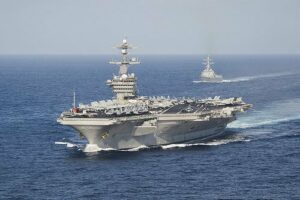
The Carrier Group
The US Navy has ordered the deployment of a strike group led by the flagship Nimitz-class aircraft carrier Carl Vinson (CVN-70) to North Korean waters, as a show of force to the secretive regime of Kim Jong Un.
The naval strike force will be stationed near the Korean Peninsula, due to rising concerns that North Korea may conduct a nuclear test in the coming days to mark the April 15 birthday of Kim Il Sung (Jong’s grandfather).
The carrier group is indeed a force to be reckoned with. It includes the Arleigh Burke-class guided-missile destroyers USS Wayne E. Meyer (DDG-108) and USS Michael Murphy (DDG-112), and the Ticonderoga-class guided-missile cruiser USS Lake Champlain (CG-57). Nuclear submarines are normally part of the deployment, and closely shadow the surface fleet.
The fleet’s air strike capabilities are provided by Carrier Wing 2, which includes the “Black Knights” of Helicopter Sea Combat Squadron (HSC) 4, the “Blue Hawks” of Helicopter Maritime Strike Squadron (HSM) 78, the “Bounty Hunters” of Strike Fighter Squadron (VFA) 2, the “Blue Blasters” of VFA-34, the “Kestrels” of VFA-137, the “Golden Dragons” of VFA-192, the “Black Eagles” of Carrier Airborne Early Warning Squadron (VAW) 113, the “Gauntlets” of Electronic Attack Squadron (VAQ) 136, and the “Providers” of Fleet Logistic Support Squadron (VRC) 30.
This is a mighty force indeed, capable of all-weather, day-or-night strike capabilities.
As the fleet steams ahead towards its deployment area, the North Korean leader Kim Jong-Un has issued a stark warning to the US.
Using traditionally tough rhetoric, Pyongyang said that the regime will counter any “reckless acts of aggression” with “whatever methods the US wants to take.” The regime referred to the deployment as a “grim situation.”
A statement released by North Korean officials read “We will make the US fully accountable for the catastrophic consequences that may be brought about by its high-handed and outrageous acts.”
Target options
US military top brass are said to be considering a range of targets around North Korea.
The country has been under close scrutiny over its nuclear weapons development program, particularly after a number of test rocket launches in recent months. Some of the rockets splashed down less than 200nmi from Japan’s northern shores. The US, a close ally of Japan, deemed this an unacceptable risk, prompting calls for action on North Korea.
According to US sources, a limited preemptive strike on a North Korean nuclear site may be carried out. This poses a problem, however, as the Carl Vinson air wing, powerful as it is, may just be short of the required might to destroy nuclear bunkers sited deep underground. Such task is normally performed via heavy ‘bunker buster’ weapons delivered by B1 or B2 long-range bombers.
The US is also aware of the retaliation capabilities of the North Korean army, plus the fact that North Korea’s ally, China, may become involved in an armed confrontation. Up to 150,000 Chinese troops have been deployed to the North Korean border over the last few days, for example, a move that is widely regarded as a precursor to war in the region.
Decapitation strike
One option said to be considered by US strategists is a so-called ‘decapitation strike’, aimed at removing the North Korean leader and a number of key officials in one swift move. This would likely be conducted via missile or drone means, though the insertion of special forces on the ground may also be on the cards.



